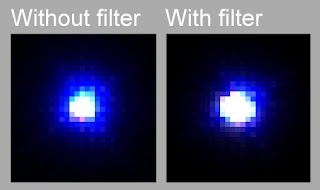After many cloudy days and nights I finally had the chance to test two things:
- does collimation of the F/4 refractor hold up against time and handling?
- how much can the blue fringes of my ED optics be improved by filtering?
Ten days ago I succesfully collimated the optics of my refractor - operating at F/4 is quite unforgiving in terms of alignment. However, it is not enough just to be able to collimate the scope and take images. I must be able to collimate the scope the evening before the eclipse, transport it for many hours in a bus over bumpy roads - and then get sharp images after setting up in the field. It has now been 10 days since the first collimation and I've transported the scope a couple hundred kilometers by car and handled the scope quite a bit.
Testing the scope on the artificial star showed that collimation had remained good! I did not even tweak it before continuing. Next, I aimed at Vega, focused using liveview in Imagesplus and ran the Eclipse Orchestrator script that will be used during the eclipse. This gave lots of shots, from which three closeup images at three different exposure times are shown below. The stellar FWHM is around 2-2.3 pixels - a bit more than last time but that could be due to different seeing conditions. The image scale is 2.86 "/pixel, so my angular resolution is around 6".
 |
| Closeup views of Vega at three different exposure times. |
The new 'fringe killer' filter was installed for the images above, but to really see the effect I have compared saturated images of Vega (1/2.5 sec, ISO 200) to identical exposures taken an earlier night without the filter. As seen below, the filter clearly reduces the intensity of the blue halo. I'd say that anything the size, price and convenience of this filter, that will help improve coronal contrast, is very welcome in my setup!
 |
| Saturated exposures of Vega showing how the Fringe Killer filter helps reduce the intensity of the blue halo. |
A more quantitative analysis of the filter performance is shown below. The graphs were made by averaging all lines of the images above. The red/green channels are unaffected by the filter, while the blue channel is reduced by ~35%. Definitely worth the effort!
 |
| Line averages from the Vega images above. Red, green, blue lines correspond to each color channel of the image; dotted lines are without the filter while full line is with filter. |







